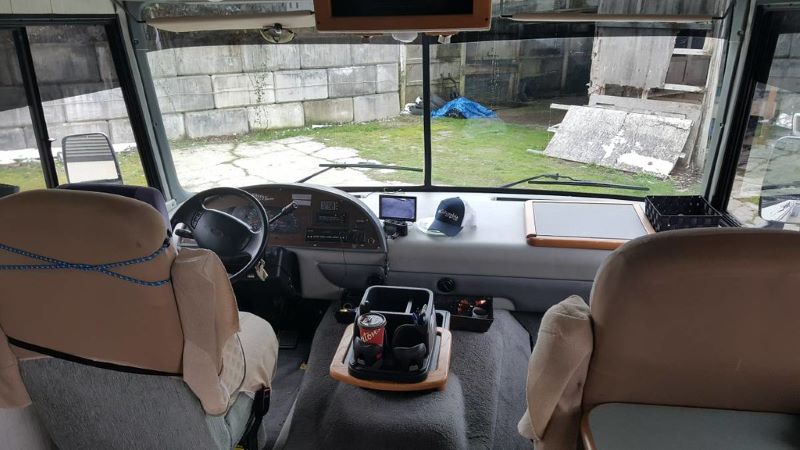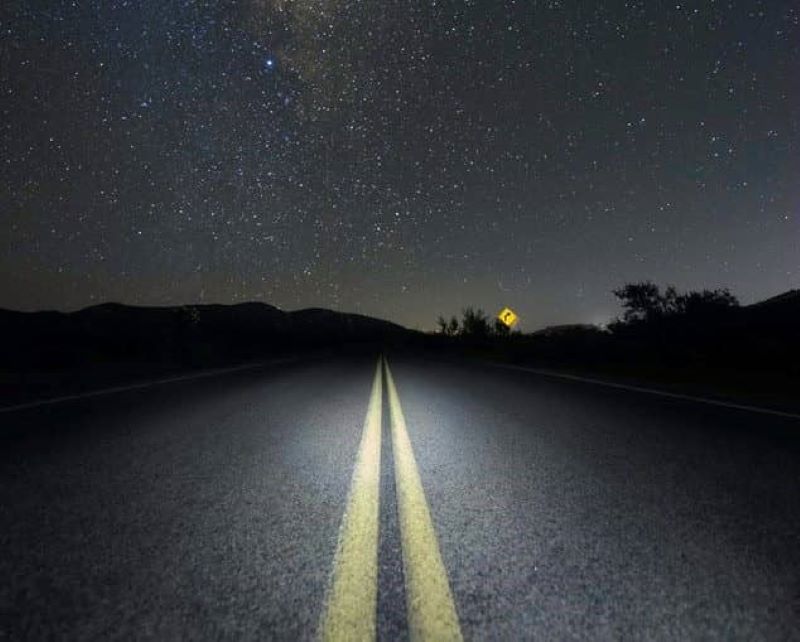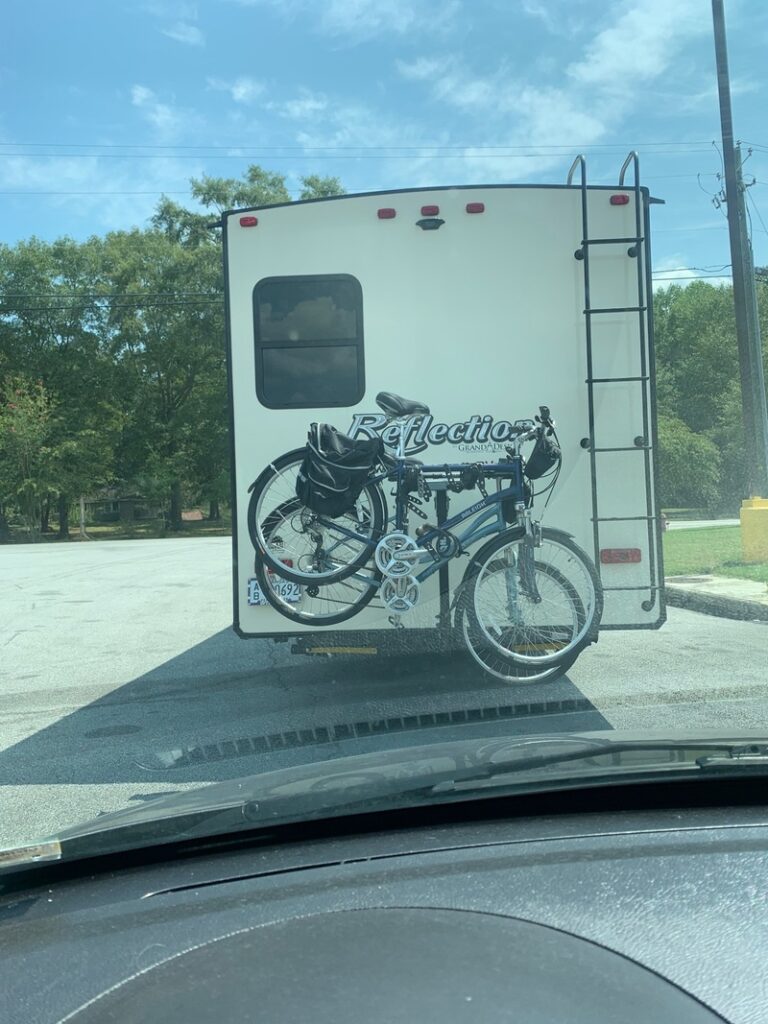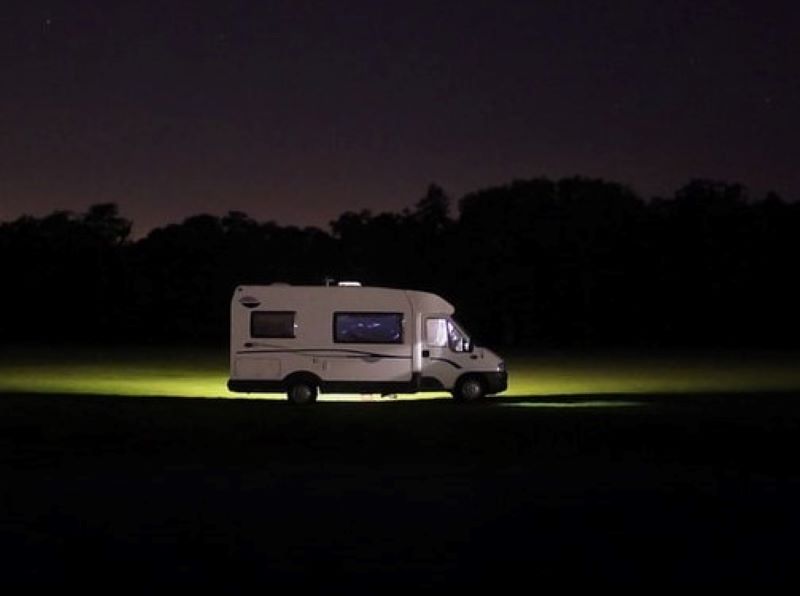Thanks for your support! If you make a purchase using our links in this article, we may make a commission. And, as an Amazon Associate, I earn from qualifying purchases. See the full disclosure here.
Driving your RV safely at night can be a bit daunting, whether you are a newbie or a veteran RVer. It can be difficult to tow or drive a large vehicle during the day in traffic but at night there are added factors that you should consider.
Of course, sticking with daylight driving is best, but you may end up in situations where you cannot avoid driving your RV at night.
It is more dangerous to drive your RV at night because your sight is limited to what your headlights show you.
Because of that, you see less of the road ahead of you and have less room and time to stop. There are, however, some things you can do to make it safer for you and your passengers.
6 Tips to Drive Your RV Safely at Night
1. Stay Alert While Driving
You’ll want to keep a weather eye out for hazards on the road like fallen branches on the road, changes in the weather, or other drivers that haven’t realized they shouldn’t be driving.
With less traffic on the road, you may not have cues from drivers ahead to prepare for something up ahead.

2. Stay Awake
Keeping yourself alert and knowing the signs that you are getting tired are important to acknowledge.
Having a second driver, if possible, so one can rest while the other drives. If you have to burn the midnight oil to get to your RV destination on time, there are trip planning apps that help with drive timing that will help you minimize driving your RV at night.
3. Consider Inside and Outside Lighting
Keep the interior lights dim so that controls are visible but are not overly bright. Harsh light can tire your eyes quicker, balance the light so glancing from the dashboard to the road ahead is not hard on your eyes.
You can use your visor at night to shield yourself from outdoor street lighting and glare. Also, avoid a fixed gaze as you drive and never stare at oncoming headlights.
Avoid being blinded by headlights by shifting your eyes down and to the right, focusing on the right edge of the road or lane markings.
4. Keep Your Windshield and Headlights Clean and Repaired
Dirty or damaged windshields can cause or increase glare, as well as decrease your visibility. Damaged headlights can also cause problems with visibility so be sure and keep both safe with regular cleanings.
As a sidenote on headlights, make sure they are angled correctly so they properly illuminate the road. If they tilt too high they can blind oncoming drivers. Go to a car dealer or a repair facility to assist you with making this adjustment. The best way to drive your RV safely at night is to make sure you’re not a road hazard.
Use your high beams appropriately. Dim them when you are within 500 feet of an oncoming vehicle and don’t use them if you are following another vehicle.

5. Slow Down and Avoid Two Lane Highways
Because of the weight of your rig, you already have a longer stopping distance. When you drive your RV at night, you experience lower visibility and therefore you have a shorter time to react to a vehicle in front of you. Adjust your speed and take that visibility into consideration.
Two-lane highways can also be a problem at night because of oncoming headlights. These roads tend to have more curves and hills than a freeway. Take a safer route if you can.
6. Watch Out for Wildlife
Collisions with deer often happen at dusk or at night, generally between October and January. High beams can help you spot an animal’s eyeshine. Avoid an accident by slowing down and acting accordingly.

Ever wonder if a deer whistle really works? Check out our blog article called Does A Deer Warning Whistle on an RV Really Work? for the scoop!
What Should a Driver do to Keep Awake and Alert
Of course, utilize caffeine to keep you alert, turn on the radio or roll down the windows for some fresh air. Talking to someone else in the vehicle might help too.
Turning down the temperature is also vital to staying awake. A cabin that is too warm will cause sleepiness. Adjust your seat so you are closer to the steering wheel. This will keep you more upright with your legs bent and less relaxed.
Driving your RV safely at night requires resisting the urge to use cruise control. You might feel like this is the ideal time to let the cruise system keep you at the right speed. You need to stay aware as much as possible, so keep your foot on the pedal.
Get out and stretch regularly to keep your blood flowing, your body moving, and your energy level up. If needed, pull over to a safe area and get some rest or just stop for the night if you can’t stay awake.
Finding a Safe Place to Pull Over for the Night
There are several places where you can pull your RV over for the night. The first that comes to mind is a rest area along the highway. These can be full of long-haul truckers who are required to stop for a specified number of hours.
Park in places designated for RVs, not in a truck space (if possible), and be sure to lock your doors. Keep your slideouts in travel mode and don’t overstay your welcome.
Check out our article on the rules of highway rest areas. It is a quick and easy guide that tells you how long you can stay and the services offered on turnpike and interstate highway rest stops.
Other safe places can include Walmart parking lots, Cabela’s or Bass Pro Shops, casinos, or even an RV park you find along the road.
Try to find a parking lot that is well lit for your safety. Paying a small fee to park is better than an accident which can cause major damage or loss of life.

7 Considerations When Driving Your RV at Night
There are a number of considerations you will face when driving your RV at night. Even though you are doing your best to drive your RV safely at night, you will have to traverse through these conditions.
1. Low Light
Low light increases stopping distances and it causes problems with depth perception. You won’t be able to gauge distances, see pedestrians, potholes, and other road hazards that might be easily visible during the day.

2. Glare
Glare from oncoming headlights makes it more difficult to see the road in front of you because your eyes require more time to adjust from the contrasting dark night and bright lights. There is a period of time between when your eyes see a light and when they actually adjust to that light.
3. Reaction time
Reaction time is the delay you have from the time you see something on the road and the time you react to it. It could be an animal crossing the road or the car in front of you hitting its brakes. Your reaction time will become longer at night when it is more difficult to see these things on the road.
4. Age
As we age, things such as reaction time slow down. Also, our ability to see at night is decreased. Both issues can cause more risk on the road.
5. Eye fatigue
When we drive for hours on end, our eyes become strained and tired. Driving at night adds additional strain on the eyes and becomes an additional risk.
6. Stopping distance
Stopping distance is affected at night because we can only see as far as our headlights shine. If we were to come upon someone or something in the road without lights, we would have difficulty stopping or maneuvering around them due to a slower reaction time. When we have thousands of pounds around or behind us, that stopping distance becomes even longer.
7. Dark Rural Roads
Driving on well-lit roads and highways is very important when driving at night. As stated earlier, the stopping distance for someone in an RV is much greater while driving at night. Reaction time at night is also compromised.
What is the 2/2/2 Rule for RVs?
Utilizing the 2/2/2 rule is a great way to have a relatively safe and stress-free RV trip. The rule means that you drive no more than 200 miles a day, stop every two hours, and stay two nights in each place. Some RVers add that you should arrive at an overnight destination no later than 2 p.m.
While using this rule keeps from wearing out the driver, it also helps to minimize stress on your RV. It also gives you some time to sightsee, take care of work, makes you feel more energized and less rushed.
Stopping every two hours helps keep you alert by giving you a chance to stretch your legs and eat or drink something.
When you get out, take a walk around your rig to check for any problems. Potential issues that are caught early can save you time, money, and major problems while you are driving. It gives you a chance to check bicycles, kayaks, or other items that are attached to your rig.

When you arrive at your nighttime destination by 2 p.m., you can set up before the sun goes down. Trying to navigate a campground at night can cause problems that would be easily avoided during daylight. You also can avoid really heavy city traffic and avoid rush hour at this time of day.
Spending two nights in each place, at minimum, allows you to rest, catch up on work and go sightseeing. If something breaks in your RV, you also have some time to get repairs done.
8 RV Trip Planning Websites and Apps
Trip planning apps can do everything from map out your route with RV-friendly roads to showing you campgrounds and scenic stops along the way.
If you are looking for fuel stops or dump stations, apps are a great way to find those things too. Find an app that gives you these features-campgrounds, scenic stops, and route tips—and you can have a lot of help at your fingertips.
Here are some of our favorite apps that we recommend:
1. Boondockers Welcome
Boondockers Welcome was originally started by a mother and daughter. It allows guests to stay at the host family’s property for free. This network of North American hosts and guests has given RVers a safe place to stay on their way to their destination. Whether it is a host family’s driveway or a 100-acre field, Boondockers Welcome is a great alternative to driving your RV at night.
2. The Dyrt Pro
Check out The Dyrt camping app for free with a 7-day trial and then for a small annual fee get The Dyrt PRO which includes over 500,000 locations with reviews and tips. Bonus, you don’t need cell reception or WiFi. Downloadable full-detailed interactive maps are available for offline browsing. Some campgrounds will even waive processing fees for campground reservations booked on The Dyrt.
3. Gas Buddy
Gas Buddy is free to download and assists drivers with finding nearby gas stations with the cheapest gas prices. The app uses your location to track where you are and find the best price.
4. Harvest Hosts
Harvest Hosts is a membership program, similar to Boondocker’s Welcome. They provide access to breweries, wineries, farms, and other unique locations that allow self-contained RVs to stay on their property overnight and enjoy their services. There are more than 3,227 places in the United States that participate in the Harvest Hosts network.
5. Overnight RV Parking
Overnight RV Parking touts the largest database of free RV parking locations in the US and Canada. The database contains 16,330 RV parking and no parking locations. Search by your current location, city, state, zip, or province code.
6. RV Life Trip Wizard
RV Life Trip Wizard (previously known as RV Trip Wizard) provides everything you will need to get to your destination safely and with little stress. You can avoid driving your RV at night because the app will help you to plan your trip with campgrounds, gas stations, and points of interest along the way.
Also, check out some 20,000 campgrounds with reviews by RVers. You’ll find safe routes based on the height and weight of your RV so you can avoid low clearances, steep grades, and propane restrictions. You can also set driving times, distances, and estimate the cost of your trip.
7. TOGO RV
The free version of TOGO RV provides you with travel destination recommendations, RV news, RV maintenance tracking, a service center, mobile RV repair locater, how-to guides, videos, and more.
For members, you can add a GPS navigation customized to your RV, savings on your favorite brands, trail maps, public land maps, and more.
8. Passport America
Since 1992, Passport America’s travel card entitles members to 50% off of the regular nightly rate on campsites in hundreds of participating campgrounds across the United States, Canada, and Mexico on a space availability basis. You can access campground information on the website or the app.
Wrapping it Up
Remember that driving or towing an RV is much different from driving a vehicle alone. You must always be alert and watch cars all around you. Your RV is large, heavy, and doesn’t stop like other vehicles. It can be exhausting under the best scenario. You want to get where you are going in the safest way and enjoy sites along the road. Traveling during the day, using the 2/2/2 rule, and driving slower are the best ways to have an enjoyable trip to your next destination.
It is this writer’s opinion and from personal experience, driving an RV at night should only be done when necessary. Driving at night is a recipe for accidents and mishaps when you are in low light. It increases stopping distances when you already have a large load behind you. Night driving makes it difficult to gauge distances and see things such as pedestrians, potholes, and stopped vehicles.
To be sure, there are times when you have no choice but to drive at night. Unforeseen circumstances, weather, and other factors dictate what we need to do. One of the best parts of the RV lifestyle is enjoying the journey, so don’t miss out.
Related Reading:
– Which RV is the Easiest to Drive?
– RV Life Pro App, GPS & RV Trip Wizard at a Discount
– 3 Best RV Security Systems For Every Category
– How To Find Free RV Camping
– FREE RV Parking Overnight At Walmart (Rules & Safety)
– Does A Deer Warning Whistle on an RV Really Work?
About the Author
Terri Nighswonger – Author and Full Time RVer
Terri Nighswonger and her husband Todd have been RVing and work camping for six years with their Cavalier King Charles Spaniel, Newton, and their Minnie Australian Shepherd, Remi.
In Addition to the RVBlogger team, Terri has written for RV Life and RV Camping Magazine and is always excited to talk about her passion for RVing and her knowledge and experience in work camping.
Writing is Terri’s passion, but she also loves hiking, kayaking, walking her dogs, and anything she can do outdoors.
They originate from the Midwest but plan to enjoy the West for a few years, wintering in Arizona and summering wherever the road may lead.


